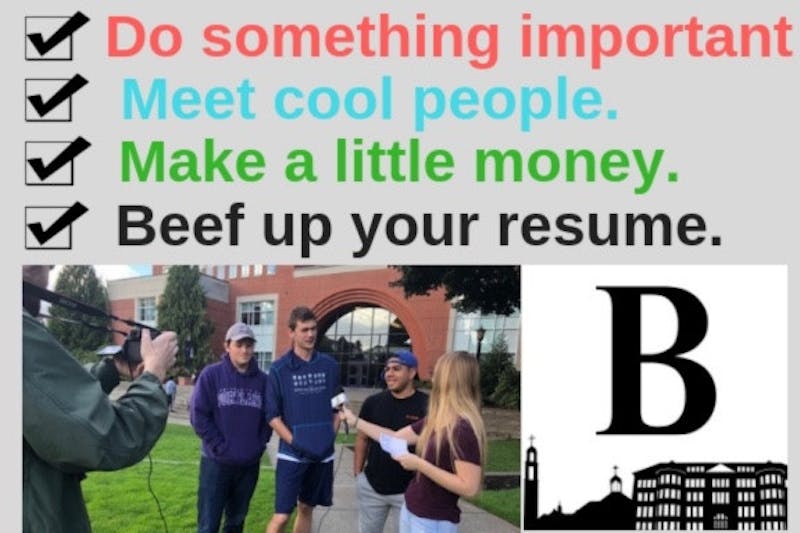Junior Katie Bauer is suited up in her lab coat to dissect the cadaver. (Stephanie Matusiefsky | The Beacon)
By Kelsey Thomas, Staff Writer thomask15@up.edu
After a few weeks, you get used to seeing cadavers on the table before you. He or she begins to lose their humanity and becomes something you are working on and learning from. Your mind becomes occupied with making sure you cut only the right thing, occasionally drifting to how gross your lab coat is - stained yellow from liquid fat - or the slight smell of the preservative engulfing the cadaver.
And yet moments come when Anatomy Laboratory students cannot help but be confronted with the humanness of the cadaver they spend at least three hours a week dissecting.
For junior Katie Bauer, this moment came while dissecting a hand.
"I had to actually hold the hand while someone else cut," Bauer said. "Her nails were pink."
Junior John Reardon recalls the second day of lab when they lifted the sheet covering the cadaver's face.
"At first it was weird," Reardon said. "But you get really used it and it gets to the point where you don't really think about it being a human anymore."
The University of Portland rents cadavers each year from the Oregon Health & Sciences University body donation program. Select students who excelled in previous anatomy classes are invited to enroll in Anatomy Laboratory and spend a semester dissecting and examining cadavers.
The students are not given the full medical history of the person, so they occasionally make discoveries of diseases or possible causes of death during dissection.
"Last year there was one that you could tell by the lungs was a heavy smoker," Bauer said.
This year, students discovered a tumor.
Each student performs an in-depth study of one part of the body.
Bauer is studying the knees and is eager to see what the cadaver's two knee surgeries look like.
Reardon is more nervous for his body part: the face.
"I'm a little worried I'll see her face in nightmares or something," Reardon said. "But I'm sure I'll be fine."
Professor Jacquie Van Hoomissen loves teaching anatomy and says that human dissection is a vital component of their program.
"Without the cadavers, students are left just looking at charts and diagrams," Van Hoomissen said. "That is fine, but that would be like learning engineering without actually ever building anything. Nobody would want to teach someone how to build a bridge without them even trying to put something together with their hands."
Van Hoomissen also teaches students that the bodies are here as a gift and deserve respect. Students must sign a sheet agreeing to a set of rules including no pictures, no bringing anyone into the lab and no putting the bodies into funny positions.
"They have always been very, very respectful," Van Hoomissen said.
OHSU is one of several programs that accepts donations of cadavers for science. According to their website, OHSU received more than 10,000 donations in the past decade. Once the bodies enter the program, they are embalmed or frozen and stored until they are distributed to their location of study.
The University of Portland applied to rent cadavers from OHSU in the early 1980s under the instruction of Marlene Moore, who previously worked for OHSU. Although the faculty were very excited to be able to practice human dissection, there are almost no records of how the program began.
"We kept it very quiet," Moore said in an email. "There were some concerns that we might be desecrating the human body."
Moore accompanied the first body to campus in the back of a van.
Human dissection has increased in public acceptance since then and is now regarded as an important component of most medical school programs. Although unallowed, Van Hoomissen has even received requests from people who wish to donate their bodies directly to the University of Portland.
In the spring, the cadavers will be returned to OHSU to be cremated or buried as the family wishes.
Occasionally, families will change their mind and want their loved ones back early. When this happened at the University of Portland last fall, the anatomy department had to return the cadaver immediately. To avoid being left without anything to study, the department currently keeps three cadavers in Swindells.
The cadaver donations are very meaningful to everyone who works on them.
"As a student and teacher of human anatomy, I was always incredibly grateful for the gift a person had given us of allowing us to study a real body," Moore said.
For Reardon and Bauer, the experience is irreplaceable.
"It's one thing to learn reading a book or staring at a poster," Reardon said. "But to actually be able to cut it open and look at what you're learning first hand is really cool and rewarding."
(Stephanie Matusiefsky | The Beacon)
(Stephanie Matusiefsky | The Beacon)
(Stephanie Matusiefsky | The Beacon)








